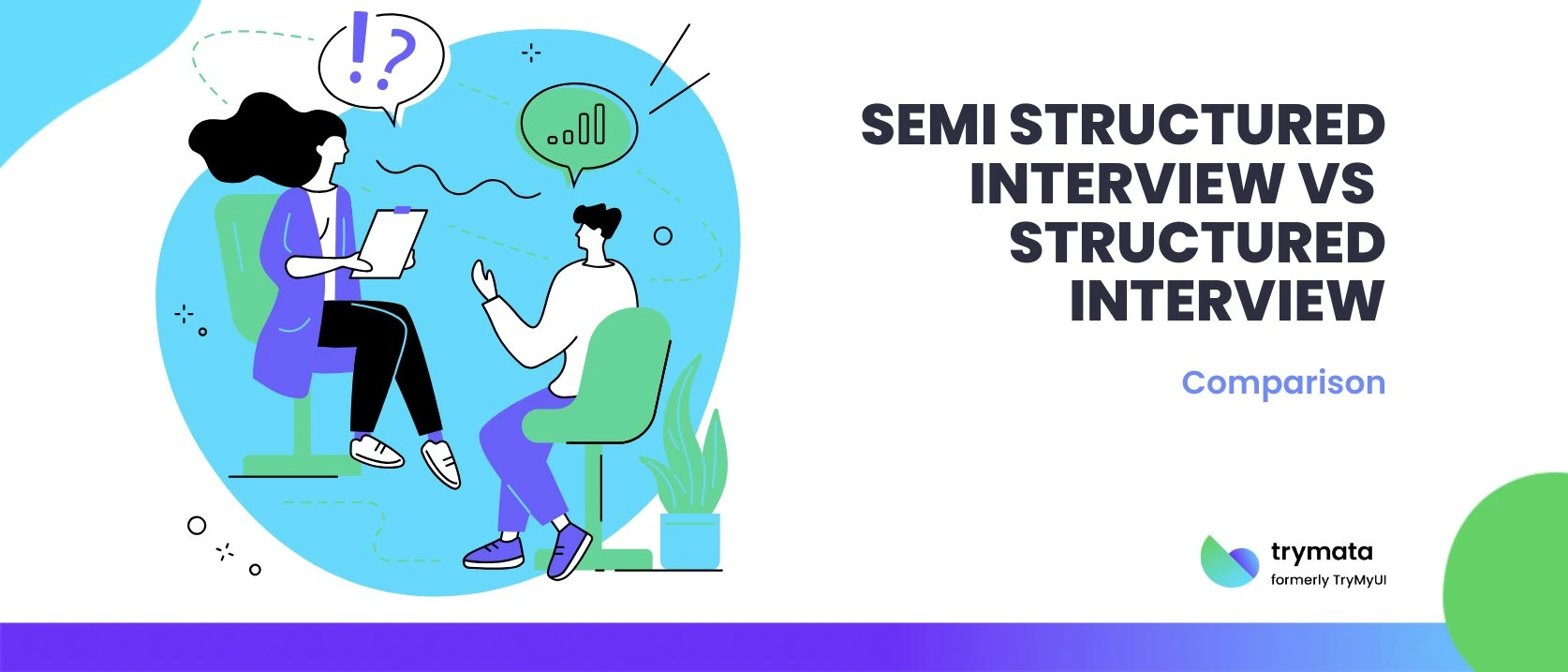When conducting interviews for research or hiring, one size rarely fits all. You might be trying to understand how users feel about a product or assess job candidates for a critical role. In either case, the type of interview you choose will shape the data collection process, the candidate experience, and the quality of insights you gain.
Two of the most popular formats are structured interviews and semi-structured interviews. But which one is right for your needs, especially when usability testing or exploring a research question in qualitative research?
In this blog, we’ll discuss the differences between semi-structured interview vs structured interview, the pros and cons of each, and when to use them based on your goals, context, and research needs.
What is Semi Structured Interview?
A semi-structured interview gives you the best of both worlds. It blends the consistency of a structured format with the flexibility of spontaneous questions. You start with an interview guide—a loose framework of semi structured interview questions, but leave space to explore deeper insights based on the participant’s responses.
This is especially powerful in usability testing. You can begin with standard questions like “What was your first impression of the interface?” and then follow the user’s experience to dig deeper, leading to a free-flowing conversation that surfaces richer qualitative data.
Advantages of Semi-Structured Interviews
Semi-structured interviews strike a balance between structure and spontaneity, bringing unique benefits.
- Allows for both open-ended questions and targeted queries,
- Excellent for social research, candidate persona development, or observational data.
- Encourages participants to share their true thoughts, boosting communication skills and insights.
- Makes it easier to tailor questions based on job requirements or the user’s experience.
Disadvantages of Semi-Structured Interviews
Still, this hybrid approach can present a few challenges depending on your goals and setting.
- It can be legally harder to justify hiring if not handled consistently.
- More training is required for interviewers to conduct interviews effectively.
- Less consistent than structured formats, which may complicate data collection across large samples.
What is a Structured Interview?
A structured interview is just what it sounds like: a thoroughly planned interaction where the interviewer asks a pre-planned set of structured interview questions in the same order for every participant. This method is designed for consistency and is often used when comparing job candidates or collecting data across a broad sample.
Think of it as a survey you speak aloud—reliable, consistent, and ideal when you need an objective comparison. For example, structured interviews in usability testing help compare responses from candidates interacting with the same design interface.
Advantages of Structured Interviews
Structured interviews offer several strengths, especially when consistency and comparability are key.
- Easy to compare candidates and answers across the board.
- Great for minimizing leading questions and interviewer bias.
- Supports quantitative research approaches with standardized data.
- Offers less stress for interviewers—everything is already mapped out.
Disadvantages of Structured Interviews
However, this format has limitations, especially when flexibility is needed.
- May feel rigid or impersonal.
- Limits room for follow-up questions or spontaneous exploration.
- Not ideal when trying to gather in-depth interviews or nuanced feedback.
Where Do Unstructured Interviews Fit In?
On the opposite end of the spectrum, unstructured interviews are completely free-form. There’s no interview guide or predetermined questions, just a natural, flowing conversation. These are typically used in exploratory research projects where the research topic is broad or in early-stage social science studies.
Structured and unstructured interviews both have their place, but if you’re conducting usability tests or trying to compare responses from several candidates, unstructured formats may lack the consistency you need.
When to Use Each Type of Interview
Not sure which format fits your goals? Here’s a quick look to help match your interview type to common research or hiring scenarios:
| Scenario | Best Interview Format |
| Comparing multiple users’ product feedback | Structured or Semi-Structured |
| Deep-diving into a user’s thoughts and behavior | Semi-Structured |
| Screening for specific job requirements | Structured |
| Building a candidate persona | Semi-Structured or Unstructured |
| Early-stage exploratory social research | Unstructured |
Conclusion
Choosing between semi structured interview vs structured interview depends on what you’re trying to learn. If you need clear, comparable data, especially for evaluating different candidates or user experiences, structured interviews keep things consistent and simple.
But if you aim for deeper insights or explore new territory, semi-structured interviews let the conversation flow naturally, leading to richer qualitative data. And while unstructured interviews are the most flexible, they’re harder to compare across participants.
The right format gives you better answers and a clearer picture of what’s really going on, whether you’re conducting usability testing, hiring, or investigating a major research question.
You may also be interested:What is one advantage of semi-structured interviews over structured interviews?
What are the major differences between structured, unstructured, and semi-structured data?
What is a weakness of semi-structured interviews?




